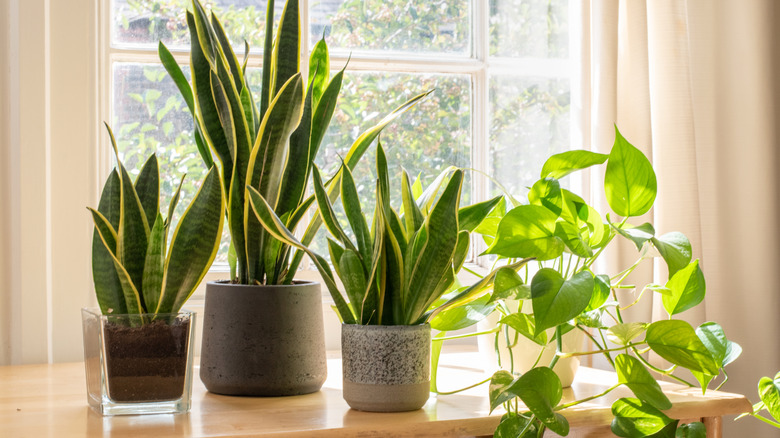The Biggest Mistake You've Been Making With Your Snake Plant
Snake plants (Dracanena spp.) are prized for their resiliency and stark beauty. You'll see them featured again and again in guides on choosing the right low-maintenance houseplant as a beginner. While it is true that snake plants are easy to tend to, making them beloved by new and seasoned plant owners alike, they still require the right environment to truly thrive. While a snake plant can survive in low light, its growth will slow. If you want to see your snake plant at its best, you need to place it in a spot where it will receive bright, indirect sunlight.
This tropical plant, which is also known as the mother-in-law's tongue, can grow as tall as 4 feet. However, some dwarf varieties stay a lot smaller. Snake plants come in a variety of leaf colors, shapes, and patterns, too. In fact, there is an abundance of snake plant varieties perfect for growing in your home and garden, and all of them are easy-going. All these hardy plants really crave is optimal lighting and a carefully maintained watering schedule. If you're guilty of keeping your snake plant in the dark, don't just up and relocate it. There are some important caveats to keep in mind before moving it.
How to transition your snake plant to bright, indirect light
If your snake plant has been growing in a poorly lit corner for a while, pause before moving it to a sunny spot. If you make this transition hastily, you risk sending your plant into shock. Instead, opt for a more calculated approach. Take about a week to slowly introduce your plant to spots with increasing amounts of sunlight, monitoring its condition as you move it. If your snake plant appears healthy, continue moving it at the pace you've set. If at any point your snake plant looks like its health is starting to decline, back off a step. For example, leaf burn is a clear sign you've introduced too much light. Your snake plant's final location should have bright, indirect light with temperatures above 50 degrees Fahrenheit.
Light isn't the only consideration when caring for a snake plant. When you move your plant from a shady spot into bright, indirect light, you will need to water it more frequently. However, you should still allow it to dry out completely before you water again to avoid root rot. And you'll likely notice your snake plant drying out faster in the spring through to the fall. Whenever possible, water the plant from below rather than above to encourage stronger, longer roots. Dust its leaves from time to time to encourage optimal photosynthesis and apply a balanced fertilizer at half strength once a month. It's time to repot your trusty snake plant after three years or if growth slows and leaves yellow.

